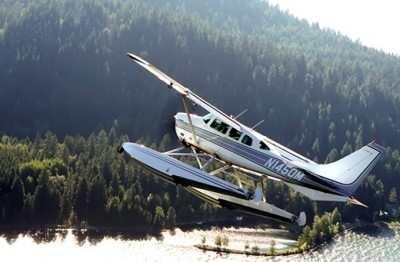Bulletin Applies To T206H Airplanes
The FAA has issued a Special Airworthiness Information Bulletin (SAIB CE-13-07R1) concerning potential in-flight fires on Cessna T206H airplanes associated with an exhaust system issue. The agency says that there is the potential for in-flight fire as a result of failure of the V-band coupling (V-band clamp) securing the tailpipe to the turbocharger or the wastegate elbow to the wastegate valve.

According to the FAA, the bulletin is the result of an in-flight fire on a Cessna T206H with only 1,000 hours time-in-service (TIS) since new. Investigation revealed the V-band coupling that secures the tailpipe to the turbocharger housing had failed in-flight resulting in hot exhaust gas impingement on the firewall and consequent burning around the base of the firewall into airplane structures. The amphibious airplane had spent approximately 700 hours TIS of its life in or near salt water.
Per the recommendations contained in the Cessna T206H maintenance manual (MM); up to the time of the fire, the incident airplane should have undergone (20) 50-hour specific inspections of the V-band coupling and had (10) annual inspections, which also identify the specific inspection of the V-band coupling. This indicates the need for greater diligence in inspection and replacement of the exhaust system Vband couplings and adherence to the recommended inspection intervals and procedures contained in the maintenance manual.
The incident coupling was of a (3) segment type, having three separate v-segments inside the flat band versus (2) v-segments. At the time, the FAA had been provided one other failed example of a 3-segment coupling from the field. There are currently two suppliers approved by Cessna for the S1921-1, one is a 3-segment coupling and the other a 2-segment coupling.
The agency's recommendations include the use of only Cessna part number S1921-1 or FAA approved PMA replacement part that is specifically approved for the Model T206H (1998 and after). There are currently two suppliers of the S1921-1 part number: Eaton (Aeroquip) and National Utilities Company (NUCO), which is further identified in the Cessna MM as “Aeroquip S1921-1” or “NUCO S1921-1”.
Also recommended is the replacement of all exhaust system V-band couplings with more than 400 hours TIS with new FAA approved original equipment manufacturer or FAA PMA V-band couplings. Thereafter, replace all exhaust system V-band couplings at 400 hours TIS or less based on condition, whichever occurs first, with new FAA-approved original equipment manufacturer or FAA PMA V-band couplings, unless the manufacturer recommends or FAA regulations require a more reduced life or more frequent replacement interval. Record the V-band coupling part number, date, and airplane hours TIS in the airplane log book.
The FAA says that, as part of all normal pre-flight inspections of the nose section, an item for the copilot’s nose area of the cowling to reach under the airplane to check the tailpipe for security in its mounting should be included. A loose tailpipe or easily displaced tailpipe should be brought to the attention of maintenance personnel prior to further operations.
Airplanes that operate in or near salt water are susceptible to corrosion of materials at a much higher rate, including stainless steel components such as V-band couplings. For airplanes in this environment, the FAA recommends a regular fresh water rinse and soap wash, with particular attention paid to those systems and components contained inside the structures that may not be directly impinged upon by the salt water in operations or the fresh water or soap washes, e.g., turbocharger housings, exhaust piping, engine accessories, etc.
(Cessna 206 float plane pictured in file photo)
 ANN's Daily Aero-Linx (04.16.24)
ANN's Daily Aero-Linx (04.16.24) Aero-News: Quote of the Day (04.16.24)
Aero-News: Quote of the Day (04.16.24) Airborne 04.10.24: SnF24!, A50 Heritage Reveal, HeliCycle!, Montaer MC-01
Airborne 04.10.24: SnF24!, A50 Heritage Reveal, HeliCycle!, Montaer MC-01 Airborne 04.12.24: SnF24!, G100UL Is Here, Holy Micro, Plane Tags
Airborne 04.12.24: SnF24!, G100UL Is Here, Holy Micro, Plane Tags Airborne-Flight Training 04.17.24: Feds Need Controllers, Spirit Delay, Redbird
Airborne-Flight Training 04.17.24: Feds Need Controllers, Spirit Delay, Redbird



